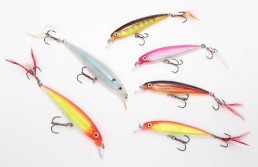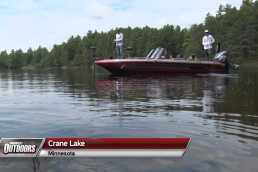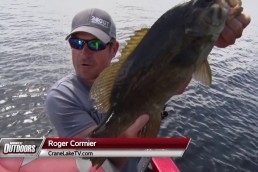My Top Smallmouth Lures of All Time
SHARE THIS POST
Our success with favorite lures and technique-specific methods depends on conditions, fish locations and habitats. At the front deck of my Ranger, I often keep 10 different St. Croix rods and reels rigged and ready to combat most smallmouth presentations. In the rod locker below, I keep several more, ready to use if necessary. Though this excessive collection isn’t needed, I’m covered for most every possible fishing tactic, and it suits my style. The diversity of my boat’s tackle selection enables me to be a more versatile angler, be open-minded to experimentation and enjoy the thrills of success with each new experience.
To determine the best lures for smallmouth bass—and keep a record of them—take down notes or keep a year-end log like I do. Likewise, are you observant and able to draw conclusions based upon fish responses?
Since 2012, I’ve created logs documenting the top-producing lures from my boat each season. Prime patterns and favorite lures are revisited each year, especially as the environment and smallmouth bass behaviors dictate their locations and influence their feeding habits. Each year, a few annual constants remain, but new discoveries and techniques succeed in the underwater world. It’s enlightening to look back upon each season’s successes and best producers.
If you were to ask me what my favorite lures are…I don’t have any. To determine which baits are better than others, it’s impossible to play favorites. What I choose to fish with is personal choice, as favored by my fisheries. Whatever puts smallmouths into the boat!
There are simply too many lures to consider. So, let’s limit the debate to within my boat.
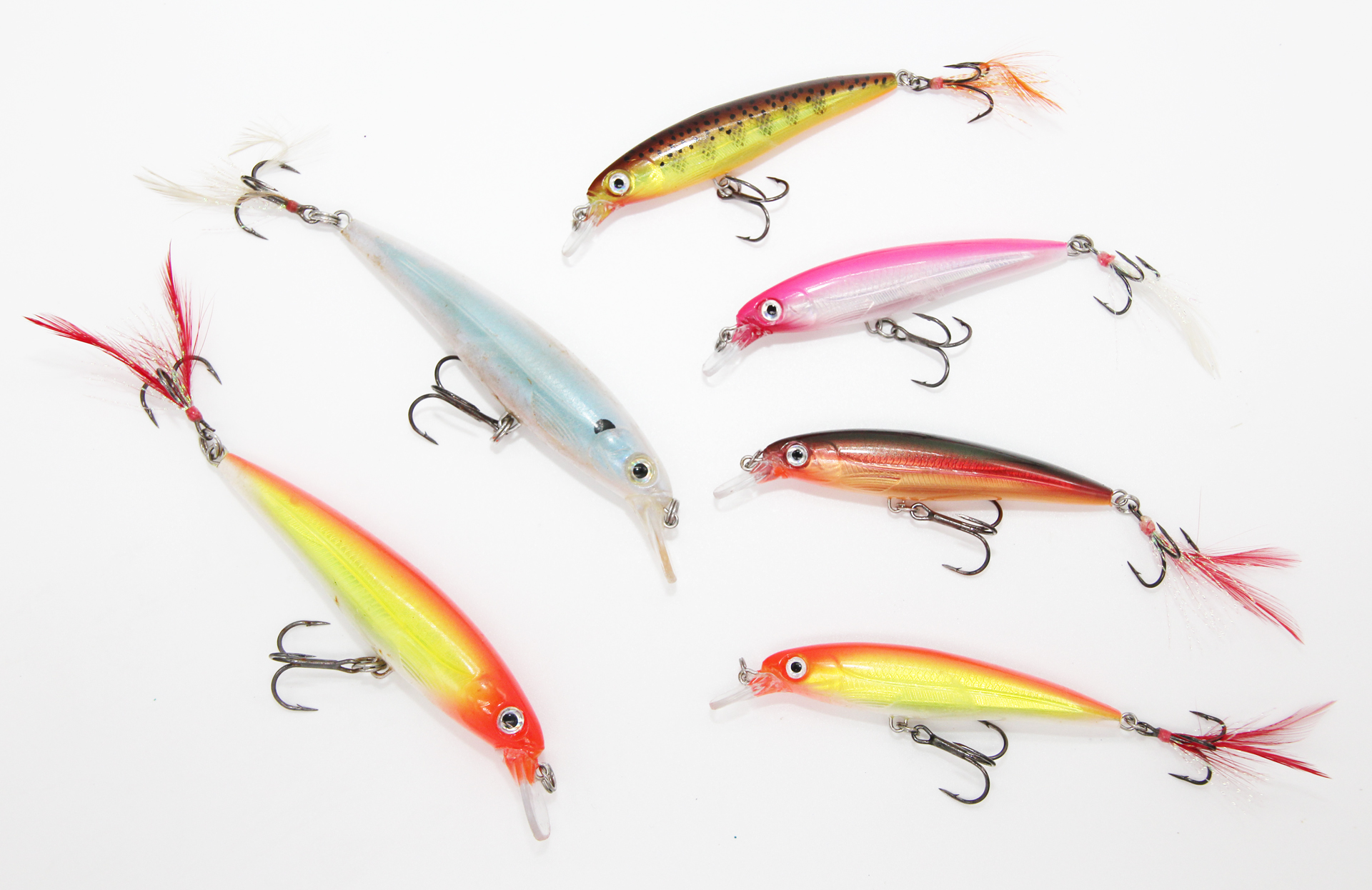
Rapala X-Rap
It’s timeless, simple and non-conditional to smallmouths. There’s no better fish catcher throughout the year.
Jerk-jerk-pause…jerk-pause-jerk. Its retrieve styles are endless and infinite. The key characteristic of the X-Rap is that it can be fished in any type of manner, according to the moods and feeding patterns of the fish. This correlates with the retrieve of the X-Rap and the way it is fished; it involves a lot of mixing and matching according to the behavior of the fish.
Nine times out of 10, smallmouths will strike on the pause. However long you choose to pause should be based on water temperature and fish activity levels.
For almost 20 years, smallmouths across the continent have remained unconditioned to the X-Rap. Never visit a smallmouth fishery without a handful of them in sizes 08 and 10. The Hot Head, Pink, Hot Mustard Muddler, River Perch, Purple Gold and Albino Shiner patterns have been my boat’s go-to in recent seasons.
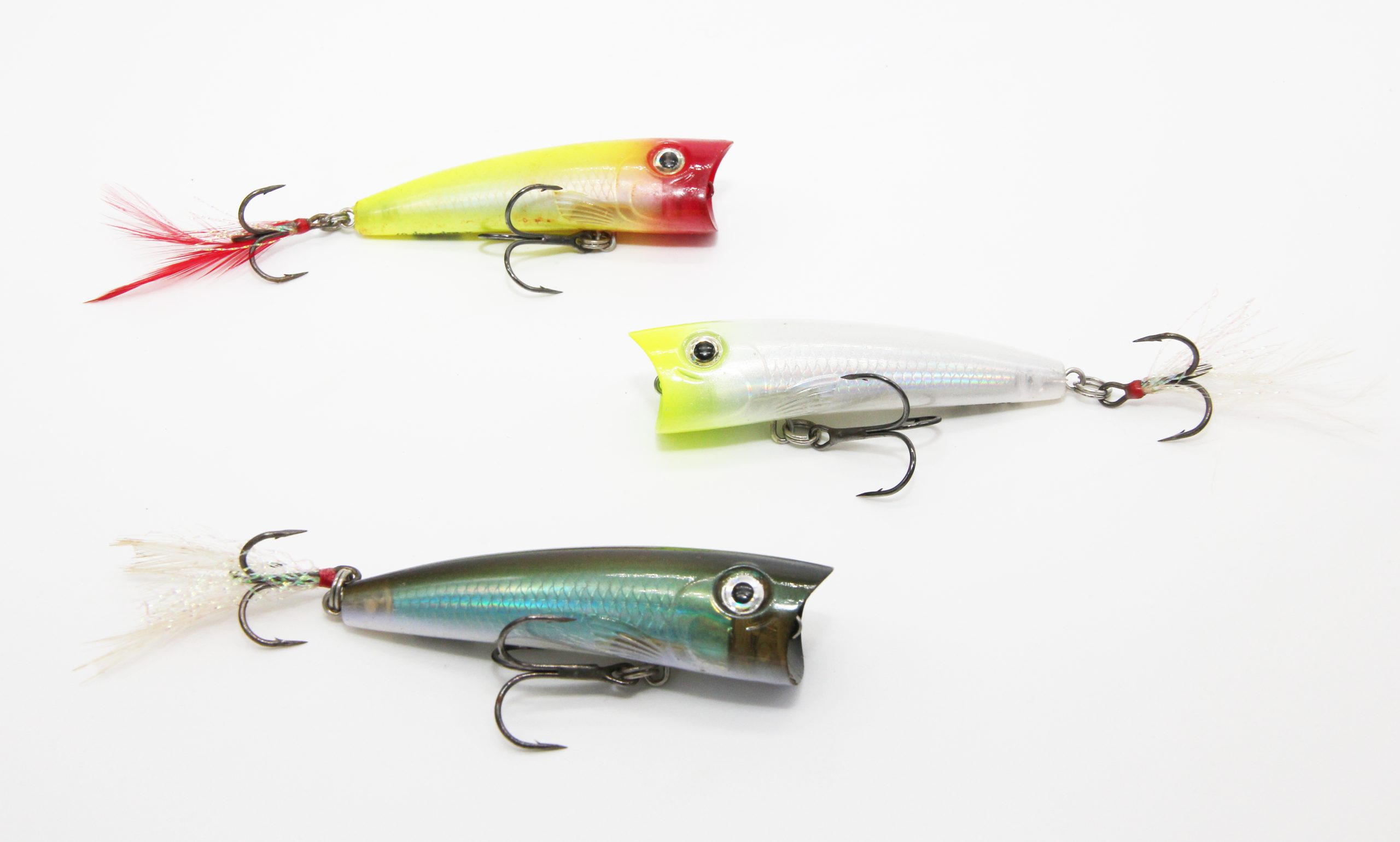
Rapala X-Rap Pop
When conditions align perfectly, tempting smallmouths atop the surface is every angler’s dream. Whether fishing lakes or rivers, it’s hard to beat popper style and walk-the-dog topwaters. The smallmouths’ curiosity draws them to these baits due to the noise, commotion and water-pushing they accomplish. Annoy and upset the fish, and you’re bound to have an explosion on your hands.
Anglers may fish topwaters to experience the thrill of a strike. On the other hand, my boat treats them as a tool for targeting the largest specimens in the lake. Topwaters are big fish baits. Most of the big smallmouths we pursue during the summer months are enticed by a variety of topwaters worked over isolated, shallow structure. From June through September, no other bait or lure type possesses the allure and attraction to big fish as topwaters.
Trophy smallmouths are engaged by size, sound and what pushes the most water to create an overhead commotion. Manufacturers continue to innovate and reinvent the wheel with new models of poppers, walkers and prop baits.
From the early June spawning period through early September, the X-Rap Pop is a fish catcher during low-light conditions and on windless days. It excels best in periods of high humidity and engages some of the largest smallmouths in the system to strike and connect. The more obnoxious and loud your pops, the more strikes it triggers.
Fish will hear it, see it and strike it from great distances. What separates this topwater from others is the amount of surface water it pushes, and the loud, obnoxious plopping sound it produces.
The only color you should need is “lemonhead—aka chartreuse ghost.
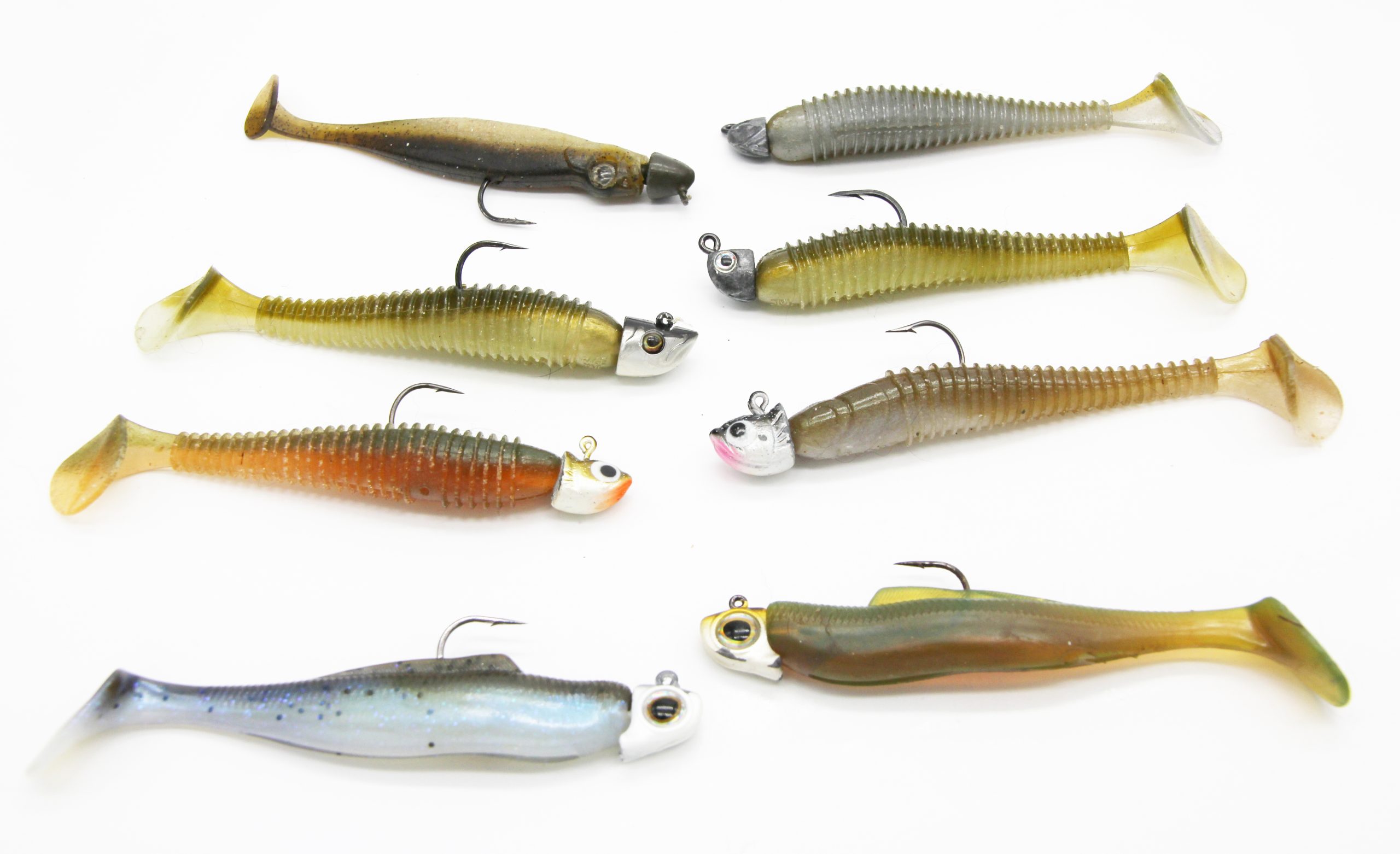
Paddletails
Paddletails and thumper-style swimbaits are among the hottest presentations right now. More anglers are fishing these hard-thumping, bass-catching softbaits for smallmouths under a variety of conditions and situations. Brands and manufacturers abound, and colorways are aplenty!
In my boat, a jig and paddletail combination remains a simple and effective fish finder. I’m sure it will play well on your favorite clear-water smallmouth fisheries, too. Rig a paddletail on a favorite swimming-style jighead for easy and engaging fishing for all anglers and skill levels.
Year-round, anytime and anywhere, we fish a variety of 3-to-5-inch models in natural and translucent patterns to catch monstrous smallmouths. On my waters, rainbow smelt, cisco, yellow perch and shiner species are the most common prey. Whichever brands you fish, pay close attention to their plastic formulation, shapes, colors and styles. Be mindful that a thin and moderately supple tail segment will produce the necessary tail-kick and movement that is critical for attraction and fishing success.
I could write a novel about each of the paddletails we utilize along with the variety of rigging methods I employ. My extensive, most-used variety includes 5.0 Big Bite Baits Suicide Shads, 3.8 Strike King Rage Swimmers, 3.8 and 2.8 Keitech Swing Impact Fats, 3-to-5-inch Z-Man Diezel MinnowZs, 3.5 and 4.5 Kalin’s Tickle Tails, 3.8 Kalin’s Sizmic Shads, and a conglomeration of custom-requested pours and homemade baits made by friends.
For best performance, it’s critical to match the body with a properly corresponding head size, shape and weight to achieve swimming and tail action, as well as hookups.
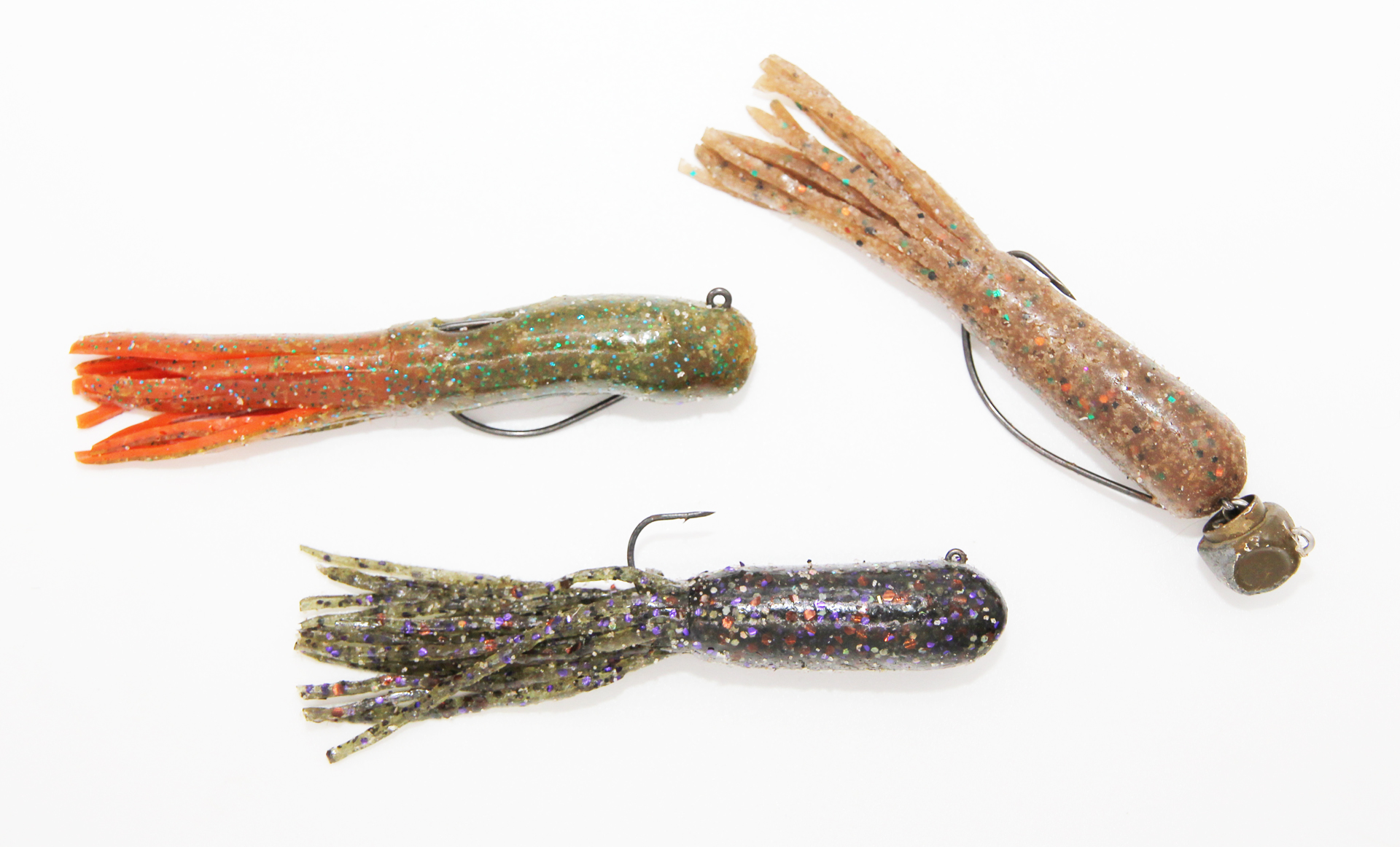
Tube jigs
Poured in appropriate shades of brown, orange, green or melon, a tube can represent a crayfish, goby or perch. Tube jigs work in all types of smallmouth water, but certain tubes work better than others. I fish tubes best with 1/16-, 1/8- and 1/4-ounce tube jig inserts. If dealing with heavy cover and rocks, I Texas rig them with weighted worm hooks. The Strike King Coffee Tube has scored hundreds of smallmouths since I first turned to them in 2013.
When it was released approximately 11 years ago, Strike King took a relatively featureless, proven winner and upped the ante with the Coffee Tube. It provides a strong, coffee-and-caffeinated scent that entices fish to bite and leads them to hold on. They are precision-cut tails for a compact presentation with lots of action. Top colors are green pumpkin, magic goby and crazy craw.
You might get more out of a Get Bit Baits 3.5″ DD Tube. Double-dipped for enhanced durability, they last much longer than most other tubes. Another good option with additional unique colors is Big Bite Baits 3.5 Salt Tubes.
In lake regions with sparse snags, I most often fish tubes with an exposed hook. It’ll simply connect with more fish and light biters. Lately I’ve been turning more to the “Stupid Rig”—a snag-proof, Texas-rigged variation with an EWG tube insert (any tube insert brand is fine). It fishes effectively and snag-free on rock piles, wood and cribs. It’s also my rig of choice when floating river systems.
Another rigging method I employ is a swinging head jig such as the 1/8- and 1/4-ounce Freedom Tackle Zodiac Jig. Utilizing an interchangeable hook system, the hybrid football jig allows the bait to swing freely, creating action. The unique design and profile of this rig allows a weedless and snag-proof presentation. When hooked, smallmouths are not able to use this tube jig as leverage when trying to shake free; thus, more fish are landed. No other specific bait or rigging combination accounts for more mid-depth and deep catches than this one.
Are you enjoying this post?
You can be among the first to get the latest info on where to go, what to use and how to use it!
When smallmouths aren’t chasing moving baits or won’t pick up another type of bottom bait, the trusty tube often saves the day. Despite being one of the most popular smallmouth lures of all time, smallmouths mostly remain unconditioned to its simplicity, seductiveness and effectiveness.
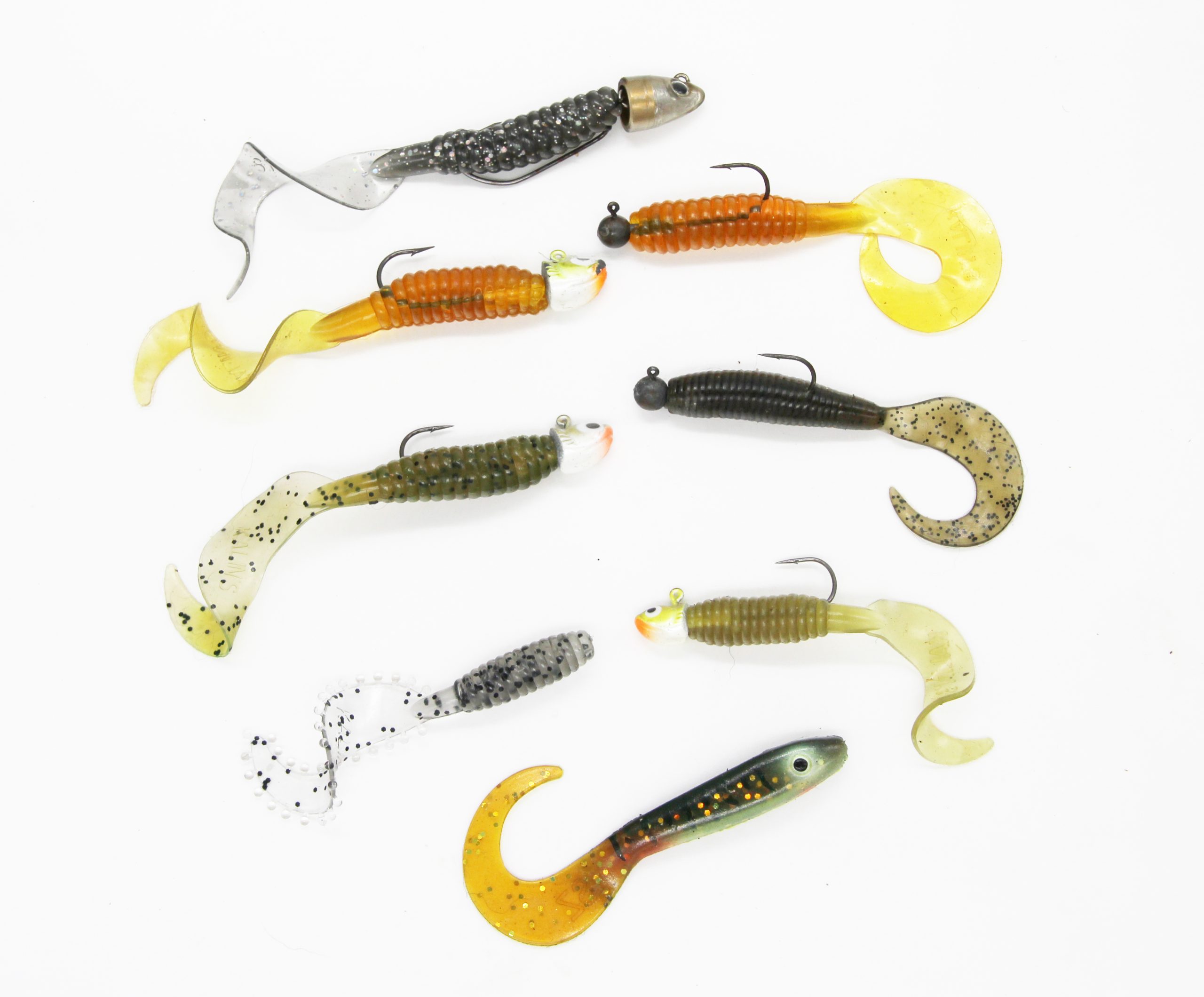
Swimming grub
Perhaps the greatest smallmouth bass bait of all time?
Grubs mesmerize smallmouths everywhere. Some lures are only seasonally productive, while others seem to always work. Whether smallmouths are active or inactive, you can rely on a grub can always for catching a few fish, no matter where.
Whether slow rolled and retrieved along bottom, high in the water column, or somewhere in-between, a swimming grub does it all.
The grubs I depend on the most are made by Kalin’s, Strike King and Berkley.
Kalin’s 5-inch Lunker Grubs fished on exposed 1/4-ounce minnow heads are my boat’s fish finders and fish catchers on most days. If downsizing is necessary, as when smallmouths are fixated on smaller prey, consider downsizing to a 3-inch Lunker Grub with 1/8-ounce head. With lighter line, it usually seals the deal.
Grubs imitate everything. On lakes, I always strive to match the hatch with natural baitfish profiles and translucent colors. On other fisheries such as river systems, smallmouths could be favoriting crayfish instead. Many grubs are available in crayfish patterns.
Casting and steadily retrieving them is the standby technique. Jigging and crawling them along the bottom under slower speeds can be done too, with the only adjustment to consider being usage of a mushroom- or football-style head.
In deeper water, you can often get a nice flurry of bites along the first breaks in 10- to 15-foot depths and atop shallow flats when drifting and covering water. Bomb cast along the breaks and run your swimmer thru the lower water column. Turning your reel once every second will maintain it at these depths. When smallmouths are shallower, downsizing your head to a 1/16- or 1/8-ounce ball- or minnow-shaped head allows you to probe skinny water.
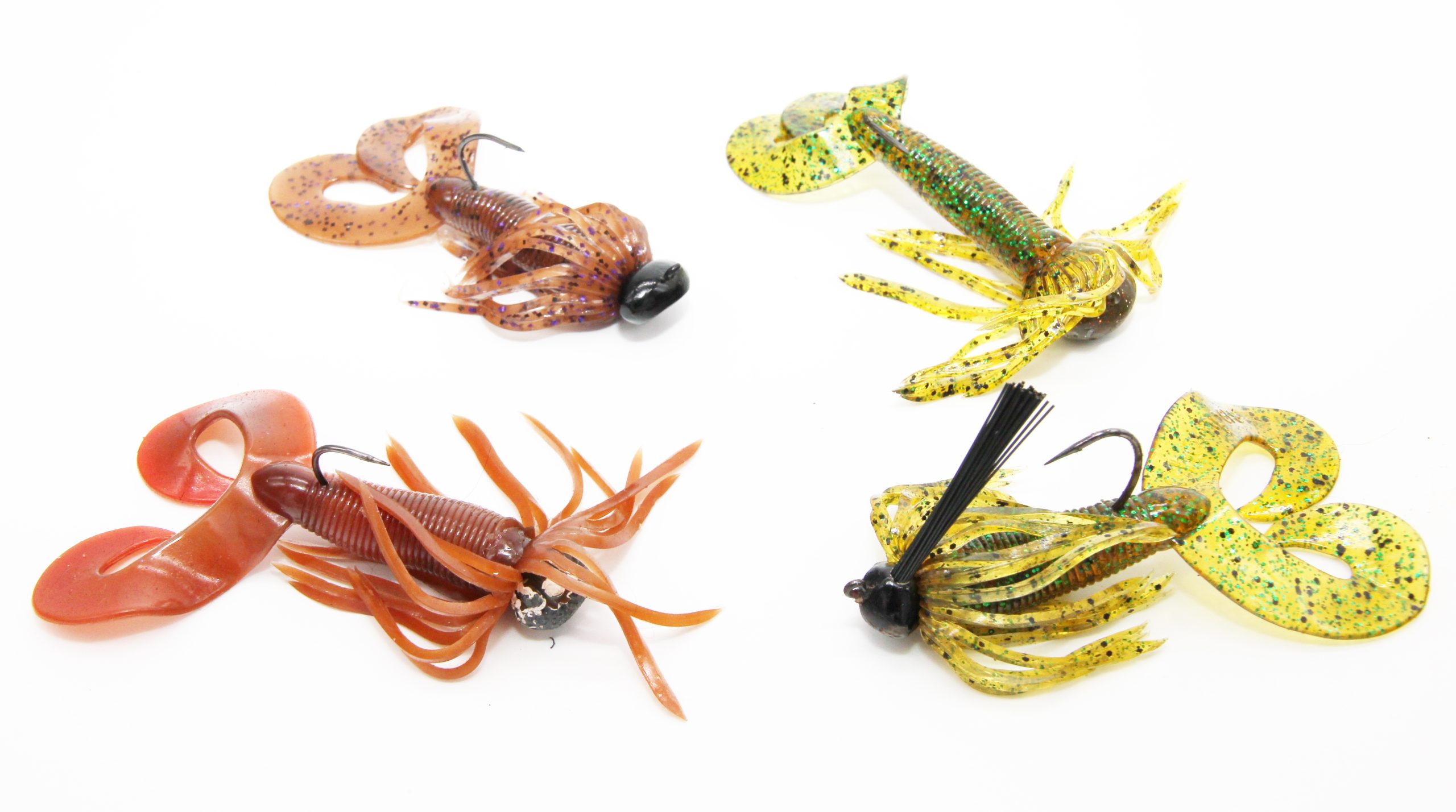
Hula grub
Since 2009, the skirted, twin-tail grub regarded as a “hula grub” has put more big smallmouth bass in my boat than anything else besides most of the baits on this list.
Best fished with a weedless bullet head in rivers, on football heads, or swinging head jigs, it is a deadly bait that represents bottom-scurrying crayfish.
Back in 2017, Trokar released a series of jigheads; the Trokar HD Shell Buster in 1/4- to 1/2-ounce sizes made a formidable combination with my favorite hula grub. I fish the combo in all depths, from shallow rock bars and flats in summer, to deep rock and wintering locations in fall.
Nowadays, a lot of soft plastics brands produce their own versions of the hula grub. Without question, my favorite is the 5-inch Chompers Skirted Twin Tail Grub. They are durable, overloaded with scented garlic goodness, and reek so bad that smallmouths laugh at us by how bad they smell to us.
My favorite colors are Orange Marmalade, Root Beer Green Flake and Cinnamon Purple Flake.
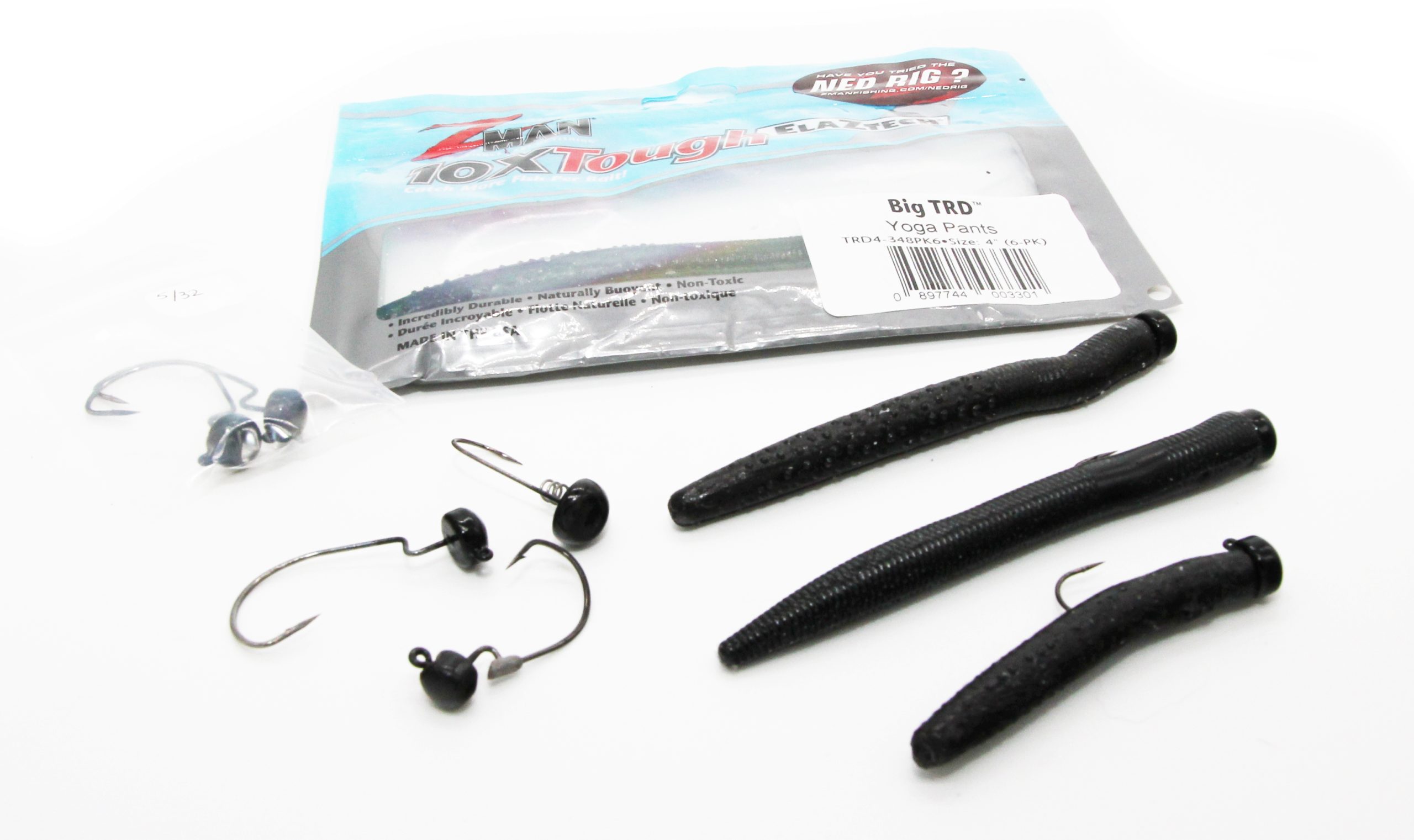
Ned rig
I didn’t pick up a Ned until 2018. Many eye-opening experiences followed. Nowadays, I always keep one tied on a 7-foot, medium-action, finesse spinning rod, whether it’s my super-size AR Rig or Z-Man’s TRD.
Rapidly becoming the greatest fish-catcher of all time, it is simple, frugal and efficient. The Ned rig has actually been around for the last half century or so, when Ned Kehde first concocted this jigworm. It excels in difficult fishing conditions, on pressured waters, and is one of the best clear-water finesse fishing options to consider. Today, several Ned rig variations are available from several manufacturers, most notably from Z-Man Finesse Baits.
With the introduction of the new Finesse TRD stickbait and Finesse ShroomZ jigheads, along with Midwest finesse staples like the Finesse WormZ, Hula StickZ, Finesse ShadZ and 3.75″ StreakZ, anglers now have all the tools needed to employ the Ned Rig and all its variations right at their fingertips. Kehde’s small jighead and plastic combo may look unassuming on the surface, but its buoyancy, slow fall, and darting action are astonishing, almost always eliciting strikes in even the toughest conditions.
Z-Man’s Finesse lineup of ElaZtech baits is designed specifically for Midwest finesse anglers. A soft and supple formulation and salt content enables these baits to exhibit precise sink rates and buoyancy, stand upright, have a lifelike action, feel realistic to fish, and the durability to withstand hundreds of fish per bait. Z-Man anglers, including my guide customers and me, believe that fish hook up more and hold on longer.
In the event smallmouths are favoring a super-sized meal, or want a bottom-oriented Ned, I often turn to my specialized AR Rig, using a 4.5-inch, all-black stick worm rigged on a 5/16-ounce mushroom head.
Be sure to check out a few other additional options. Every soft plastics manufacturer is molding their own variation of the Ned rig. We’ve scored success with Missile Baits Ned Bombs, Bizz Baits Ned Dizzy, 3-inch YUM Dingers, 3-inch Yamamoto Senkos, 3-inch Reaper tail plastics, and Berkley MaxScent Flat Worms, to name a few.
It’s a numbers presentation, but it’s also one that targets some of the largest bass living in the most pressured lake systems. It’s also the bait to use when smallmouths don’t show interest in tubes or other bottom-dwelling, jigging methods. It’s a trip-saver in cold fronts. It’s also a guide’s lifesaver.
Even though many anglers fishing the rig are scoring gargantuan numbers of bass and experiencing 50- to 100-fish days with it as a finesse option, the Ned rig is my solution for big smallmouths when they’re fixated on leech patterns—typically from mid-June through August. But it is also a year-round fish catcher.
I bomb cast it for long distances and hop and dead stick it along the bottom to imitate a leech. Always keep pressure on the line to detect the most subtle bites. An immediate hookset results in the bass connecting with hook in the roof of the jaw, 99% of the time. You will want the 7’1″ MXF Victory (Finesse), and Legend Tournament Bass LBTS71MF (Versatile) spinning.
I fish my Neds as a bottom presentation. This calls for full bottom contact and use of a heavier head. I fish it with a 5/16-ounce mushroom head custom-poured by our friend Gregg Kizewski of 3G Smallmouth Solutions in St. Germain, Wis. For snaggy situations, such as dealing with rock piles wood and cribs, Gregg also makes them weedless with his Next Level Jig that can be Texas rigged.
When choosing my top smallmouth lures, my criteria revolve around fish production for both numbers and trophies, followed by forage basics in catering to where I fish. Admittedly, my GOAT (greatest of all time) lures might not work as well down South, across the Great Lakes, or further north in Canada—but I wouldn’t be on it!
All things considered, what are your GOAT lures?
MWO
SHARE THIS POST
Did you enjoy this post?
You can be among the first to get the latest info on where to go, what to use and how to use it!
Andrew Ragas
Andrew Ragas splits time between Chicago and Wisconsin’s Northwoods. Based in Minocqua, Wis., he specializes in trophy bass fishing and offers guided trips from May through October. While big bass are his passion, he dabbles in multispecies, as well. He may be visited online at northwoodsbass.com
